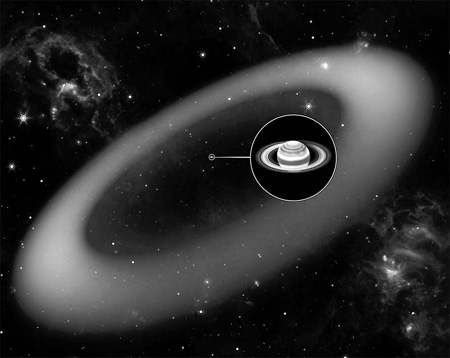Saturn moon is lord of the rings
|
An artist's rendering released by NASA's Jet Propulsion Laboratory shows the biggest but never-before-seen ring around Saturn. The inset shows an enlarged image of Saturn, as seen by the W.M. Keck Observatory in Hawaii in infrared light. AP/NASA |
PARIS: Stunned astronomers have discovered that a small, distant moon of Saturn has the largest ring in the Solar System.
Phoebe, a Saturnian satellite measuring only 214 kilometers across, has a circle of dusty debris with a diameter of some 13 million kms, they reported yesterday in the weekly British science journal Nature.
The newly found ring is so huge it would take 1 billion Earths to fill it. If the ring were visible from Earth, it would appear to be twice the size of the full moon.
A trio of US astronomers led by Anne Verbiscer of the University of Virginia used the orbiting Spitzer telescope in February this year to get a close look at space in Phoebe's neighborhood. The other two are Douglas Hamilton of the University of Maryland, College Park, and Michael Skrutskie, also of the University of Virginia.
"This is one supersized ring," said Verbiscer.
The ring's orbit is tilted 27 degrees from the planet's main ring plane, according to NASA's Jet Propulsion Laboratory (JPL).
JPL spokeswoman Whitney Clavin said the ring is very diffused and doesn't reflect much visible light but the infrared Spitzer telescope was able to detect it.
Although the ring dust is very cold - minus 316 degrees Fahrenheit - it shines with thermal radiation.
No one had looked at its location with an infrared instrument until now, Clavin said.
Until now, the champion planetary rings in the Solar System were so-called "gossamer rings" surrounding Jupiter, the Solar System's largest planet, and Saturn's E ring.
Phoebe's ring is far fainter than both, and appears to comprise dust from rocks bashed off the little moon by interplanetary debris or other particles.
The ring may answer the riddle of another moon, Iapetus, which has a bright side and a very dark side.
"Astronomers have long suspected that there is a connection between Saturn's outer moon Phoebe and the dark material on Iapetus," said Hamilton. "This new ring provides convincing evidence of that relationship."
The ring circles in the same direction as Phoebe, while Iapetus, the other rings and most of Saturn's other moons go the opposite way. Migrating dust from the ring could spiral into Iapetus, coating one side of it with a dark material that, over the life of the Solar System, could be meters thick.
There is a so-called thermal segregation theory to explain this.
It suggests that the dark side of Iapetus, by absorbing more sunlight, is able to warm sufficiently to cause local water ice to evaporate. The vapor then circulates to condense on the nearest cold spot, on the icy, bright side of the moon.
As a result, the dark side loses its surface ice, and thus becomes darker, while the bright side accumulates ice, and gets brighter.
AFP-AP
(China Daily 10/08/2009 page8)















